Ambulatory care is on the rise, accounting for one-third of healthcare spending in the United States, according to an article in the July issue of Health Facilities Management. That figure is slightly more than inpatient care. The growth can be attributed to a number of factors, including new reimbursement models, new care protocols and even healthcare consumer demands and expectations.
This sector isn’t without its challenges. Because of convenience and popularity, capacity at these centers is at an all-time high. Patient loads are staggering, creating wait times to get an appointment and then to see a doctor long and frustrating. Patient retention can be an issue. Loyalty to one physician for many years no longer is the trend, and the ambulatory sector is realizing this, the article notes. The Affordable Care Act and its requirements also are changing the face of outpatient care, moving a focus on wellness vs. hospitalization.
With this in mind, modern ambulatory care facilities need to be much more than clinical space. These facilities need to adapt to changing medical practices and emerging technologies and provide a wide range of services that attract new patients and retain existing ones. The facilities also need to be future-proofed so they remain relevant as time passes.
All of this requires careful planning and recognition of eight key ambulatory design trends, as the article points out. These factors that drive design include lean process improvement, shared medical appointments, telehealth services, hospital-employed physicians, flexibility for the future, population-growth tracking, inpatient needs and the trend toward combined urgent care and ambulatory clinics. Consideration of these drivers can allow project teams to design an ambulatory care center that work as well today as it does in the future.
Read the article.

 Healthcare Is the New Retail
Healthcare Is the New Retail Bridgeway Behavioral Health Services Launches Campaign to Renovate Health Center
Bridgeway Behavioral Health Services Launches Campaign to Renovate Health Center Ground Broken for New North Dakota State Hospital
Ground Broken for New North Dakota State Hospital AI Usage for Healthcare Facilities
AI Usage for Healthcare Facilities Ground Broken on Pelican Valley Senior Living Modernization Project
Ground Broken on Pelican Valley Senior Living Modernization Project